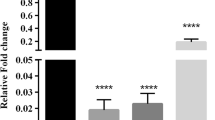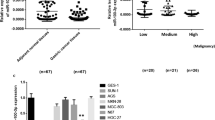Abstract
Background
Gastric cancer (GC) is one of the most common cancers with the majority of patients recognized in advanced stages. The efficacy of using docosahexaenoic acid (DHA) as a supplementary agent has been suggested in treatment along with chemotherapeutics including docetaxel. However, the molecular signatures of such beneficial effects are not well-understood.
Objective(s)
We aimed to evaluate the effects of DHA and docetaxel on the expression level of metastasis-related genes, including MMP-2 and talin-2, and their controlling miRNAs, miR-106b and miR-194, in metastatic GC cell line, MKN45.
Method(s)
GC cell line, MKN45, was cultured, and determination of IC50 of DHA was done by MTT test. Cells were treated with docetaxel, DHA, and their combination for 24 h, and then total RNA was extracted and cDNA synthesis was done using standard protocols. The expression level of target genes, MMP-2 and talin-2, and miR-106b and miR-194 were determined by using quantitative real-time PCR.
Results
The expression level of MMP-2 was decreased significantly in all treated cells. However, talin-2 showed significant downregulation only after treatment with docetaxel. In contrary to increased expression after treatment with docetaxel, DHA led to a significant under-expression of miR-106b. The similar effect was seen for miR-194.
Conclusion(s)
Combination of docetaxel and DHA led to the significant downregulation of MMP-2. Also, DHA lowered the docetaxel-mediated upregulation of miR-106b oncomiR. In conclusion, supplementation of docetaxel therapy with DHA in GC patients would be considered as a beneficial approach in cancer treatment.


Similar content being viewed by others
References
Benbrahim Z, El Mekkaoui A, Lahmidani N, Ismaili Z, Mellas N. Gastric cancer: an epidemiological overview. Epidemiology (Sunnyvale). 2017;7:304. https://doi.org/10.4172/2161-1165.1000304.
Goetze OT, Al-Batran SE, Chevallay M, Monig SP. Multimodal treatment in locally advanced gastric cancer. Updat Surg. 2018;70(2):173–9.
Lee JH, Kim SH, Oh SY, Lee S, Lee H, Lee HJ, et al. Third-line docetaxel chemotherapy for recurrent and metastatic gastric cancer. Korean J Intern Med. 2013;28(3):314–21.
Al-Batran SE, Pauligk C, Homann N, Schmalenberg H, Kopp HG, Haag GM, et al. LBA-008Docetaxel, oxaliplatin, and fluorouracil/leucovorin (FLOT) versus epirubicin, cisplatin, and fluorouracil or capecitabine (ECF/ECX) as perioperative treatment of resectable gastric or gastro-esophageal junction adenocarcinoma: The multicenter, randomized phase 3 FLOT4 trial (German Gastric Group at AIO). Annals of oncology: official journal of the European Society for Medical Oncology. 2017;28(suppl_3). https://doi.org/10.1093/annonc/mdx302.007
Calder PC. Docosahexaenoic acid. Ann Nutr Metab. 2016;69(Suppl 1):7–21.
Song EA, Kim H. Docosahexaenoic acid induces oxidative DNA damage and apoptosis, and enhances the chemosensitivity of cancer cells. Int J Mol Sci. 2016;17(8).
Newell M, Baker K, Postovit LM, Field CJ. A critical review on the effect of docosahexaenoic acid (DHA) on cancer cell cycle progression. Int J Mol Sci. 2017;18(8).
Harries M, O'Donnell A, Scurr M, Reade S, Cole C, Judson I, et al. Phase I/II study of DHA-paclitaxel in combination with carboplatin in patients with advanced malignant solid tumours. Br J Cancer. 2004;91(9):1651–5.
Guo XL, Lin GJ, Zhao H, Gao Y, Qian LP, Xu SR, et al. Inhibitory effects of docetaxel on expression of VEGF, bFGF and MMPs of LS174T cell. World J Gastroenterol. 2003;9(9):1995–8.
Inoue K, Chikazawa M, Fukata S, Yoshikawa C, Shuin T. Docetaxel enhances the therapeutic effect of the angiogenesis inhibitor TNP-470 (AGM-1470) in metastatic human transitional cell carcinoma. Clin Cancer Res. 2003;9(2):886–99.
Li H, Qiu Z, Li F, Wang C. The relationship between MMP-2 and MMP-9 expression levels with breast cancer incidence and prognosis. Oncol Lett. 2017;14(5):5865–70.
Zhong Y, Lu YT, Sun Y, Shi ZH, Li NG, Tang YP, et al. Recent opportunities in matrix metalloproteinase inhibitor drug design for cancer. Expert Opin Drug Discovery. 2018;13(1):75–87.
Yuan Y, Li L, Zhu Y, Qi L, Azizi L, Hytonen VP, et al. The molecular basis of talin2's high affinity toward beta1-integrin. Sci Rep. 2017;7:41989.
Xu YF, Ren XY, Li YQ, He QM, Tang XR, Sun Y, et al. High expression of talin-1 is associated with poor prognosis in patients with nasopharyngeal carcinoma. BMC Cancer. 2015;15:332.
Tang H, Yao L, Tao X, Yu Y, Chen M, Zhang R, et al. miR-9 functions as a tumor suppressor in ovarian serous carcinoma by targeting TLN1. Int J Mol Med. 2013;32(2):381–8.
Asadi M, Shanehbandi D, Zafari V et al. J Gastrointest Canc (2018). https://doi.org/10.1007/s12029-018-0154-8.
Chen X, Wang Y, Zang W, Du Y, Li M, Zhao G. miR-194 targets RBX1 gene to modulate proliferation and migration of gastric cancer cells. Tumour Biol. 2015;36(4):2393–401.
Petrocca F, Vecchione A, Croce CM. Emerging role of miR-106b-25/miR-17-92 clusters in the control of transforming growth factor beta signaling. Cancer Res. 2008;68(20):8191–4.
Yang TS, Yang XH, Chen X, Wang XD, Hua J, Zhou DL, et al. MicroRNA-106b in cancer-associated fibroblasts from gastric cancer promotes cell migration and invasion by targeting PTEN. FEBS Lett. 2014;588(13):2162–9.
Kazemi T, Shekari N, Asghari F, Haghnavaz N, Shanehbandi D, Khaze V, et al. Let-7a could serve as a biomarker for chemoresistance against docetaxel in gastric cancer. Anti Cancer Agents Med Chem. 2018;19.
D'Eliseo D, Velotti F. Omega-3 fatty acids and cancer cell cytotoxicity: implications for multi-targeted cancer therapy. J Clin Med. 2016;5(2).
Yun EJ, Song KS, Shin S, Kim S, Heo JY, Kweon GR, et al. Docosahexaenoic acid suppresses breast cancer cell metastasis by targeting matrix-metalloproteinases. Oncotarget. 2016;7(31):49961–71.
Shaikh IA, Brown I, Schofield AC, Wahle KW, Heys SD. Docosahexaenoic acid enhances the efficacy of docetaxel in prostate cancer cells by modulation of apoptosis: the role of genes associated with the NF-kappaB pathway. Prostate. 2008;68(15):1635–46.
Shinto L, Marracci G, Bumgarner L, Yadav V. The effects of omega-3 fatty acids on matrix metalloproteinase-9 production and cell migration in human immune cells: implications for multiple sclerosis. Autoimmune Dis. 2011;2011:134592.
Hansen RA, Harris MA, Pluhar GE, Motta T, Brevard S, Ogilvie GK, et al. Fish oil decreases matrix metalloproteinases in knee synovia of dogs with inflammatory joint disease. J Nutr Biochem. 2008;19(2):101–8.
Yau WL, Lam CS, Ng L, Chow AK, Chan ST, Chan JY, et al. Over-expression of miR-106b promotes cell migration and metastasis in hepatocellular carcinoma by activating epithelial-mesenchymal transition process. PLoS One. 2013;8(3):e57882.
Cheng Y, Guo Y, Zhang Y, You K, Li Z, Geng L. MicroRNA-106b is involved in transforming growth factor beta1-induced cell migration by targeting disabled homolog 2 in cervical carcinoma. J Exp Clin Cancer Res. 2016;35:11.
Smith AL, Iwanaga R, Drasin DJ, Micalizzi DS, Vartuli RL, Tan AC, et al. The miR-106b-25 cluster targets Smad7, activates TGF-beta signaling, and induces EMT and tumor initiating cell characteristics downstream of Six1 in human breast cancer. Oncogene. 2012;31(50):5162–71.
Zheng R, Pan L, Gao J, Ye X, Chen L, Zhang X, et al. Prognostic value of miR-106b expression in breast cancer patients. J Surg Res. 2015;195(1):158–65.
Zhang GJ, Li JS, Zhou H, Xiao HX, Li Y, Zhou T. MicroRNA-106b promotes colorectal cancer cell migration and invasion by directly targeting DLC1. J Exp Clini Cancer Res. 2015;34:73.
Shekari N, Baradaran B, Shanehbandi D, Kazemi T. Circulating microRNAs: valuable biomarkers for the diagnosis and prognosis of gastric cancer. Curr Med Chem. 2018;25(6):698–714.
Ni X, Xia T, Zhao Y, Zhou W, Wu N, Liu X, et al. Downregulation of miR-106b induced breast cancer cell invasion and motility in association with overexpression of matrix metalloproteinase 2. Cancer Sci. 2014;105(1):18–25.
Chen S, Chen X, Xiu YL, Sun KX, Zhao Y. Inhibition of ovarian epithelial carcinoma tumorigenesis and progression by microRNA 106b mediated through the RhoC pathway. PLoS One. 2015;10(5):e0125714.
Li J, Wang JM, Liu YH, Zhang Z, Han N, Wang JY, et al. Effect of microRNA-106b on the invasion and proliferation of trophoblasts through targeting MMP-2. Zhonghua Fu Chan Ke Za Zhi. 2017;52(5):327–32.
Roessler C, Kuhlmann K, Hellwing C, Leimert A, Schumann J. Impact of polyunsaturated fatty acids on miRNA profiles of monocytes/macrophages and endothelial cells-a pilot study. Int J Mol Sci. 2017;18(2).
Fang KP, Dai W, Ren YH, Xu YC, Zhang SM, Qian YB. Both talin-1 and talin-2 correlate with malignancy potential of the human hepatocellular carcinoma MHCC-97 L cell. BMC Cancer. 2016;16:45.
Debrand E, Conti FJ, Bate N, Spence L, Mazzeo D, Pritchard CA, et al. Mice carrying a complete deletion of the talin2 coding sequence are viable and fertile. Biochem Biophys Res Commun. 2012;426(2):190–5.
Li L, Li X, Qi L, Rychahou P, Jafari N, Huang C. The role of talin2 in breast cancer tumorigenesis and metastasis. Oncotarget. 2017;8(63):106876–87.
Zhao Y, Li F, Zhang X, Liu A, Qi J, Cui H, et al. MicroRNA-194 acts as a prognostic marker and inhibits proliferation in hepatocellular carcinoma by targeting MAP4K4. Int J Clin Exp Pathol. 2015;8(10):12446–54.
Li Z, Ying X, Chen H, Ye P, Shen Y, Pan W, et al. MicroRNA-194 inhibits the epithelial-mesenchymal transition in gastric cancer cells by targeting FoxM1. Dig Dis Sci. 2014;59(9):2145–52.
Zhang Y, Chen C, Hu K. MiR-194 suppresses human gastric cancer cell proliferation and induces apoptosis by targeting GGCT. Int J Clin Exp Pathol. 2017;10(3):2589–98.
Le XF, Almeida MI, Mao W, Spizzo R, Rossi S, Nicoloso MS, et al. Modulation of microRNA-194 and cell migration by HER2-targeting trastuzumab in breast cancer. PLoS One. 2012;7(7):e41170.
Funding
This study was done by a grant from Infectious and Tropical Diseases Research Center, Tabriz University of Medical Science, Tabriz, Iran. (Grant number: 13098).
Author information
Authors and Affiliations
Corresponding author
Ethics declarations
Conflict of Interest
The authors declare that they have no conflict of interest.
Additional information
Publisher’s Note
Springer Nature remains neutral with regard to jurisdictional claims in published maps and institutional affiliations.
Rights and permissions
About this article
Cite this article
Shekari, N., Javadian, M., Ghasemi, M. et al. Synergistic Beneficial Effect of Docosahexaenoic Acid (DHA) and Docetaxel on the Expression Level of Matrix Metalloproteinase-2 (MMP-2) and MicroRNA-106b in Gastric Cancer. J Gastrointest Canc 51, 70–75 (2020). https://doi.org/10.1007/s12029-019-00205-0
Published:
Issue Date:
DOI: https://doi.org/10.1007/s12029-019-00205-0




